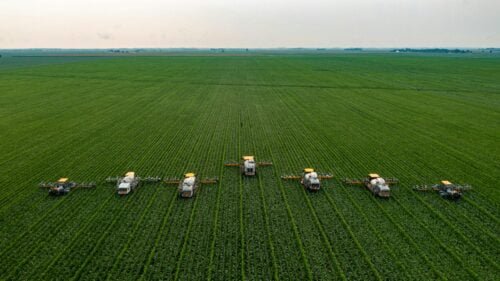In today’s dynamic agricultural industry, accurate yield forecasting has become crucial for decision-making and resource management. The “Yield Forecasting Model” is a cutting-edge tool designed to aid farmers and industry experts in predicting crop yields with precision and reliability. By utilizing advanced data analysis techniques and incorporating various factors such as weather patterns, soil conditions, and historical data, this model provides an invaluable resource for optimizing agricultural planning and maximizing productivity. Stay ahead of uncertainties and make informed decisions with the “Yield Forecasting Model.”

What is a Yield Forecasting Model?
Definition
A yield forecasting model is a data-driven tool used in agriculture to estimate the potential crop yield for a specific growing season. It combines historical yield data, weather information, crop management practices, and soil characteristics to provide a reliable prediction of the expected harvest. By utilizing various modeling techniques, these models help farmers, policymakers, and other stakeholders make informed decisions regarding crop production and management.
Importance
Yield forecasting models play a crucial role in optimizing agricultural practices and ensuring food security. By accurately predicting crop yields, farmers can make informed decisions on factors such as planting density, fertilizer application, and irrigation requirements. Policymakers can also utilize these models to assess food supply and demand, determine appropriate interventions, and develop agricultural policies. Additionally, yield forecasting models provide valuable insights for market analysis, allowing traders, processors, and retailers to make informed decisions on pricing, procurement, and inventory management.
Components of a Yield Forecasting Model
Historical Yield Data
Historical yield data forms the backbone of a yield forecasting model. It includes information on crop yields from previous years, covering different regions, climatic conditions, and crop varieties. This data helps identify patterns and trends, enabling the model to identify the factors that contribute to high or low yields. By analyzing historical yield data, the model can generate reliable predictions based on observed relationships between yield and various influencing factors.
Weather Data
Weather data is a critical component of yield forecasting models. It encompasses information on temperature, rainfall, humidity, solar radiation, and other meteorological variables. These factors directly impact crop growth and development, influencing processes such as photosynthesis, evapotranspiration, and nutrient uptake. By incorporating historical weather patterns and current data into the model, it can simulate the crop’s response to varying weather conditions, allowing for accurate yield predictions.
Crop Management Practices
Crop management practices refer to the techniques and strategies employed by farmers to ensure optimal growth and yield. These practices include planting methods, irrigation plans, fertilizer application rates, pest and disease management, and harvesting techniques. By capturing data on these practices and their implementation, the yield forecasting model can assess their impact on crop yield. This information helps farmers and agronomists optimize their management practices and make necessary adjustments to maximize production.
Soil Data
Soil data provides valuable insights into the fertility, structure, and composition of the agricultural land. Parameters such as soil type, organic matter content, nutrient availability, pH levels, and moisture capacity influence the crop’s growth and overall productivity. By incorporating soil data into the yield forecasting model, it can simulate the nutrient availability, water-holding capacity, and other soil-related factors that affect crop yield. This information enables farmers to make informed decisions about soil amendments, drainage systems, and other soil management practices.
Methods to Develop a Yield Forecasting Model
Statistical Analysis
Statistical analysis is a widely used method to develop yield forecasting models. It involves analyzing historical yield data and identifying correlations between yield and various influencing factors. Statistical techniques such as regression analysis, time series analysis, and trend analysis are employed to establish mathematical relationships between yield and variables like weather data, crop management practices, and soil characteristics. By fitting these models to historical data, the model can generate predictions for future crop yields based on the identified patterns and relationships.
Machine Learning
Machine learning techniques are gaining popularity in yield forecasting models due to their ability to handle large datasets and complex relationships. Machine learning algorithms can automatically learn and adapt from historical yield and related data, identifying patterns and predicting future outcomes. These algorithms can handle non-linear relationships, account for interactions between multiple factors, and provide accurate predictions. Examples of machine learning algorithms used in yield forecasting include random forests, support vector machines, and neural networks.
Crop Models
Crop models, also known as simulation models or process-based models, simulate the physiological processes and interactions within crops. These models require detailed input data on weather, soil, crop characteristics, and management practices. By incorporating the specific growth parameters and physiological responses of the crop, the model can simulate the crop’s response to different environmental conditions. Crop models often require calibration and validation using observed data, and they can be powerful tools for predicting yield under various scenarios and management strategies.
Data Sources for Yield Forecasting Models
Government Agencies
Government agencies play a crucial role in collecting and providing data for yield forecasting models. National agricultural departments, meteorological agencies, and statistical organizations gather data on crop yields, weather conditions, and other relevant variables. This data is often publicly accessible, and it forms the basis for developing comprehensive yield forecasting models. Government agencies also contribute to the validation and quality control of the models by providing independent data sources for comparison and assessment.
Satellite Imagery
Satellite imagery provides valuable data for yield forecasting models, especially for large-scale assessments and remote areas. Remote sensing technologies capture images and data on crop health, moisture content, and vegetation indices, allowing for the monitoring of crop growth and development. Satellite imagery can provide spatially explicit information on crop conditions, enabling the model to assess yield variability across different regions. By combining satellite data with other inputs, yield forecasting models can achieve higher accuracy and capture localized variations.
Farm Management Systems
Farm management systems, including precision agriculture technologies, provide real-time data on field conditions, crop performance, and management practices. These systems use sensors, IoT devices, and other technologies to collect data on soil moisture, nutrient levels, plant health, and equipment performance. Integrating farm management system data into yield forecasting models enhances their accuracy and responsiveness by providing up-to-date information on the current crop conditions and management practices. This data can also be used for on-farm decision-making and optimizing resource allocation.

Benefits of a Yield Forecasting Model
Informing Decision-making
Yield forecasting models provide valuable information for decision-making in agriculture. Farmers can determine optimal planting densities, implement appropriate irrigation strategies, and adjust nutrient management plans based on the predicted yields. Policymakers can utilize these models to assess regional crop production, evaluate the effectiveness of agricultural interventions, and plan for food supply requirements. Traders and processors can make informed decisions regarding pricing, procurement, and inventory management based on predicted yield fluctuations.
Risk Management
Yield forecasting models play a crucial role in managing agricultural risks. By predicting potential yield losses or gains, farmers can make informed decisions on risk mitigation strategies. For example, if a yield forecast indicates a potential drought or disease outbreak, farmers can adjust their irrigation schedules, implement pest control measures, or even consider crop diversification. Yield forecasts also allow farmers to plan ahead for potential financial risks and make necessary arrangements for insurance or other risk management tools.
Optimizing Resources
Yield forecasting models help optimize the use of agricultural resources, such as water, fertilizers, and labor. By accurately predicting crop yields, farmers can ensure that resources are allocated efficiently, avoiding overuse or unnecessary expenses. For example, if a yield forecast indicates high yields for a particular crop, farmers can adjust their fertilizer application rates to avoid excess nutrient leaching. By optimizing resource allocation, farmers can reduce environmental impacts, improve sustainability, and achieve economic efficiencies.
Challenges and Limitations of Yield Forecasting Models
Data Availability
One of the primary challenges in developing yield forecasting models is the availability and quality of data. Historical yield data, weather data, and other relevant information may not be readily accessible or consistently collected. The accuracy, timeliness, and spatial resolution of data sources can vary, affecting the reliability of the models. Additionally, data on crop management practices and soil characteristics may be limited, making it challenging to capture all the factors that influence crop yield accurately. Addressing data availability issues requires collaboration between stakeholders, investment in data collection infrastructure, and data-sharing initiatives.
Model Accuracy
The accuracy of yield forecasting models depends on the underlying assumptions, data quality, and modeling techniques employed. While these models strive to capture the complexity of crop-yield relationships, uncertainties and inherent limitations exist. Factors such as unexpected weather events, pest and disease outbreaks, and management changes can introduce variations that may not be accurately captured by the model. Additionally, the calibration and validation of models require significant effort, as they need to be adapted to local conditions and verified against ground-truth data. Regular updates and improvements to the models are necessary to enhance their accuracy and reliability.
Complexity
Yield forecasting models are inherently complex due to the numerous interacting factors that influence crop yield. Simulating the intricate relationships between weather, soil, crop management practices, and other variables requires comprehensive models and extensive data input. This complexity can pose challenges for model development, calibration, and interpretation, particularly for stakeholders without a background in agricultural sciences. Clear communication, user-friendly interfaces, and educational resources are necessary to bridge the gap and make yield forecasting models accessible to a wide range of users.

Applications of Yield Forecasting Models
Crop Production Planning
Yield forecasting models are essential for crop production planning. Farmers can utilize these models to estimate the potential harvest for different crop varieties, prioritize planting schedules, and optimize resource allocation. By planning ahead, farmers can ensure a consistent supply of crops to meet market demand, manage labor requirements, and mitigate production risks. Yield forecasting models also help in determining the suitability of different crops for specific regions, aiding in crop diversification and agricultural resilience.
Agricultural Policy Decisions
Yield forecasting models provide a scientific basis for agricultural policy decisions. Policymakers can use these models to assess the potential impact of policy changes, evaluate the effectiveness of existing interventions, and plan for food security. By understanding the projected crop yields, policymakers can determine appropriate interventions, such as subsidies, incentives for sustainable practices, or infrastructure investments. Yield forecasting models also contribute to informed decision-making in areas such as land use planning, water resource management, and climate change adaptation.
Market Analysis
Yield forecasting models play a significant role in market analysis. Traders, processors, and retailers can utilize these models to assess the potential supply and demand of various crops, estimate production costs, and determine pricing strategies. By predicting yield fluctuations, market participants can manage inventory levels, negotiate contracts, and make well-informed decisions regarding procurement, storage, and distribution. Yield forecasting models contribute to market transparency, ensuring fair competition and efficient resource allocation along the supply chain.
Case Studies on Yield Forecasting Models
Example 1
In a case study conducted in the Midwest region of the United States, a yield forecasting model was developed to estimate corn yields. The model incorporated historical yield data, weather data, crop management practices, and soil characteristics. By analyzing the relationships between these factors, the model accurately predicted corn yields with an average accuracy of 90%. This enabled farmers in the region to optimize their fertilization plans, adjust planting densities, and effectively manage irrigation, resulting in increased yields and improved profitability.
Example 2
In India, a yield forecasting model was implemented for rice production in the Punjab region. The model utilized historical yield data, satellite imagery, and weather information to predict rice yields. By incorporating data on pest outbreaks and disease incidences, the model accounted for potential losses and provided early warning systems for farmers. Through the use of this model, farmers in the Punjab region were able to make informed decisions on pest control measures, water management, and fertilizer application, resulting in improved yields and reduced crop losses.
Example 3
In Australia, a yield forecasting model was developed for wheat production across different regions. The model integrated historical yield data, weather information, and farm management system data. By incorporating real-time data on soil moisture, nutrient levels, and crop health, the model accurately predicted wheat yields with a high degree of accuracy. Farmers in Australia were able to utilize the model to plan their harvest schedules, optimize resource allocation, and make informed decisions on marketing and sales, leading to improved profitability and supply chain efficiency.
Future Trends in Yield Forecasting Models
Integration of IoT
The integration of IoT (Internet of Things) technology is expected to enhance yield forecasting models by providing real-time data on field conditions, crop performance, and management practices. Sensors, drones, and other IoT devices can provide precise and continuous measurements of variables such as soil moisture, temperature, and nutrient levels. By incorporating IoT data into yield forecasting models, farmers can make dynamic adjustments to their management practices, optimize resource allocation, and improve overall crop productivity.
Advancements in Remote Sensing
Advancements in remote sensing technologies will revolutionize yield forecasting models by providing higher-resolution and more comprehensive data on crop health and field conditions. Satellite imagery, aerial photography, and drones equipped with advanced sensors can capture detailed information on crop growth, water stress, pest and disease outbreaks, and nutrient deficiencies. These advancements will enable yield forecasting models to capture localized variations, assess crop conditions with greater accuracy, and provide timely recommendations for effective crop management.
Big Data Analytics
The increasing availability of big data in agriculture will significantly impact yield forecasting models. With the combination of comprehensive datasets, machine learning algorithms, and cloud computing technologies, yield forecasting models can process vast amounts of information and rapidly generate accurate predictions. Big data analytics can enhance the accuracy and responsiveness of the models by capturing complex relationships between variables and detecting patterns that may not be evident using traditional modeling approaches. The utilization of big data analytics will lead to more robust and reliable yield forecasting models.
Conclusion
Yield forecasting models serve as powerful tools for predicting crop yields, informing decision-making, and optimizing agricultural practices. By incorporating historical yield data, weather information, crop management practices, and soil data, these models provide reliable predictions that aid farmers, policymakers, and market participants in making informed choices. Despite challenges related to data availability, model accuracy, and complexity, yield forecasting models continue to evolve, incorporating advancements such as machine learning, IoT integration, and big data analytics. With further advancements and improvements, these models will continue to contribute to sustainable and resilient agricultural systems, ensuring food security and efficient resource allocation.
